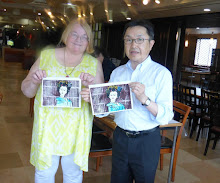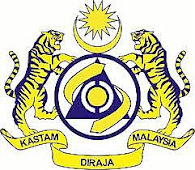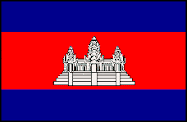From Cocoon to Yarn
We now move to the next phase of the silk making process - that of turning these furry little golden yellow cocoons into beautiful silk thread.
Above: Boiling the cocoons
Silkworm cocoons, known as golden silk, are boiled to help detach the silk from the worm. This process is called degumming and after it's done the cocoon goes into another boiling pot to have the fine silk layer fished out.
The girls working here all seemed very shy and let me take their photos. They were all very industrious and I could see the look of concentration on their faces. They really care about what they do and seem to take great pride in their work.
Above: Extracting the silk thread
The next stage - another boiling pot for the fine silk. It was so fine, I could barely see it - even though I had my glasses on. I swear it was so fine that even Superman with his X ray vision would have had difficulty. The guide lifted some threads up for me with the aid of tongs and let me feel it, remarking on how strong it was. It may be finer than the finest spiderweb, but the thread was very strong in spite of it's delicate look.
Above: Extracting the silk thread
Further on in the process, the extracted thread is spooled and wrapped on to big wheels to give it more tension.
Above: Spinning racks
The big chunks you see in the foreground is the raw silk - the yarn is wound on the spinning racks.
Above: Natural dyes
The silk is dyed naturally, using plant roots, extracts from plants, leaves and even bark and rusty nails to get the beautiful colours you can see here.
Above: Weaving
In this photo, the young girl is moving the shuttle (threaded with the silk thread) from left to right. I stood watching as she, and others wove the silk. The shuttle was moved from right to left, then the weaver places both hands on a piece of wood which is the width of the fabric and pulls this towards her, she then moves the shuttle from left to right, then pulls the wide piece of wood towards her again. This is repeated time and time again. It takes one day to weave one metre of silk.
There were several girls weaving, from the simplest of plain fabric to the more intricate patterns. One fabric which was very beautiful with many colours had fourteen different shuttles - one for each colour! The work is back breaking and the constant motion of moving the shoulders and arms would no doubt have me running for the nearest doctor with backache! Honestly, I didn't know how they could do this for it is arduous and not for the faint hearted.
And seeing these young women at work, gave me an insight as to why hand woven products are so highly prized. No machine could produce such beautiful fabrics and designs.
Above: Lunch!
As we moved along, I noticed these fish and thinking they were part of the dyeing process asked, "What sort of fish are they and what are they for?"
Bunneano looked at me and said, "Lunch!"
Oh, I felt like it was foot in mouth time!☺
Malaysia Time
Click On Your Flag To Translate
Malaysia and Cambodia
Hello,
This is about my upcoming trip to Malaysia and Cambodia. The first part is pre-trip - information about flights, itineraries, accommodation and all the things that you need to do to plan an overseas holiday. This is my first trip to Asia and I hope it may help others. Comments are very welcome and anyone who has travelled to Malaysia and/or Cambodia, please feel free to comment and offer any advice or tips that you think would be helpful. As of today ( 28th February) , in exactly 11 days (minus 30 minutes) I will be in Kuala Lumpur.
Cheers.
I had the most amazing time and hope you enjoy reading about my trip. Each post is numbered and I'm doing them in order from start to finish - a little like a diary.
ANGKOR WAT SUNRISE
This is about my upcoming trip to Malaysia and Cambodia. The first part is pre-trip - information about flights, itineraries, accommodation and all the things that you need to do to plan an overseas holiday. This is my first trip to Asia and I hope it may help others. Comments are very welcome and anyone who has travelled to Malaysia and/or Cambodia, please feel free to comment and offer any advice or tips that you think would be helpful. As of today ( 28th February) , in exactly 11 days (minus 30 minutes) I will be in Kuala Lumpur.
Cheers.
I had the most amazing time and hope you enjoy reading about my trip. Each post is numbered and I'm doing them in order from start to finish - a little like a diary.
Subscribe to:
Post Comments (Atom)















No comments:
Post a Comment